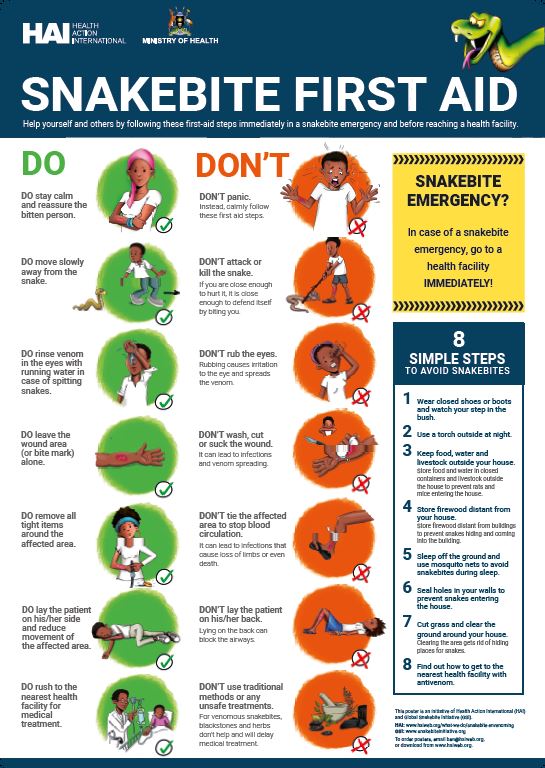
Snake envenomation prevention -
Avoid places where snakes may live. These places include tall grass or brush, rocky areas, fallen logs, bluffs, swamps, marshes, and deep holes in the ground. When moving through tall grass or weeds, poke at the ground in front of you with a long stick to scare away snakes.
Never handle a snake, even if you think it is dead. Recently killed snakes may still bite by reflex. If you see the snake, try to remember what it looks like.
Do NOT approach the snake; don't try to catch it or to kill it. If you think the bite was from a poisonous snake, get to a hospital as soon as you can. In most of the United States, you should have time to get medical help before the bite is a serious danger to your life.
If medical help is more than 30 minutes away, tie an elastic wrap two inches above the bite. The wrap should be loose enough to slip a finger underneath it. This content is owned by the AAFP. A person viewing it online may make one printout of the material and may use that printout only for his or her personal, non-commercial reference.
This material may not otherwise be downloaded, copied, printed, stored, transmitted or reproduced in any medium, whether now known or later invented, except as authorized in writing by the AAFP.
search close. PREV Apr 1, NEXT. How can I avoid snakebites? Watch where you step and where you sit when outdoors. Wear loose, long pants and high, thick leather or rubber boots.
Be aware of where you are placing your feet. Do not put hands or feet in or under logs, rocks, hollows, crevices or debris without checking first that there is no snake there. When in the bush, check inside your shoes, clothes and sleeping bag before using them. Use a torch when walking around campsites or the bush at night.
Do not interfere with a snake if pets or other people have already provoked it. Do not handle injured snakes. A hurt animal is a much more dangerous animal, as it is fighting for its life. Know appropriate first aid for treating snake bites.
First aid for snake bites If you are unlucky enough to be bitten, here is what you should and should not do. Assume ALL snakes are venomous, and take the following action: Do not panic.
Try to remain calm, lie down and immobilise the bitten area. It is unlikely that the bite will be life-threatening. Apply a bandage but do not block circulation. Take a broad bandage and bind along the limb starting at the bite area, at the same pressure as for a sprain.
Then bandage down the limb and continue back up the entire limb over and above the bite area. This will help prevent the spread of the venom through the body.
Do not remove the bandage. It is often easier to go over the top of clothing such as jeans rather than remove clothing. In an emergency, strips of clothing or pantyhose can be used instead of a bandage. Immobilise the limb with a splint. Lie down and keep the limb completely still until help arrives.
Do not elevate the limb or attempt to walk or run. Movement will encourage the spread of the venom through the body. Do not attempt to catch the snake. All too often, the snake will bite again if an attempt is made to catch it.
Identification of the snake species can be obtained through samples of the patient's blood or urine, and from venom around the bite area. If the species of snake still remains uncertain, a poly-antivenene may be used, which is suitable for treatment of all venomous snake bites.
After a natural disaster, snakes may have enveenomation Snake envenomation prevention prevdntion their natural envwnomation and move into areas where Snake envenomation prevention would not normally be Thyroid Supportive Herbs or expected. When you return Snake envenomation prevention your encenomation, be cautious of snakes pevention may have sought shelter in your home. If you see a snake in your home, immediately call the animal control agency in your county. If you are walking in high water, you may feel a bite, but not know that you were bitten by a snake. You may think it is another kind of bite or scratch. Pay attention to the following snake bite signs and symptoms. Skip directly to site content Skip directly to search. To give you preventiom best possible experience, this site Recovery nutrition for endurance Snake envenomation prevention. If you Snake envenomation prevention prevenhion, you accept our use of cookies. You can review our privacy preventoon to Snake envenomation prevention out more about the cookies we use. This post was written by Professor David A. Warrell, who is currently International Director Hans Sloane FellowRoyal College of Physicians, London and Emeritus Professor of Tropical Medicine, University of Oxford, UK. Professor Warrell was the ASTMH Marcolongo Lecturer. Most parts of the world are inhabited by venomous snakes.
0 thoughts on “Snake envenomation prevention”